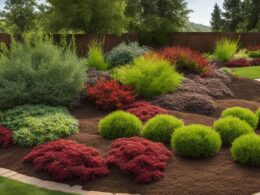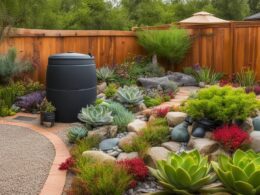Create a vibrant and sustainable green space with these low-water garden design strategies. By implementing drought-tolerant landscaping, you can save water while still maintaining a beautiful garden. Replace water-guzzling lawns with water-wise plantings and incorporate hardscape elements like walkways and sculptures. Choose drought-tolerant plants such as ornamental grasses, evergreens, and perennials to create a lush and water-saving landscape. Use porous materials for hardscape elements to allow moisture to be absorbed by the soil. Consider planting in tiers or dense flowerbeds to provide shade and reduce water evaporation. Mulch is essential for water conservation and can also serve as a permeable walkway. Use native plants and group plants with similar watering needs together. Consider using containers with neutral colors to make plants stand out.
Key Takeaways:
- Create a vibrant and sustainable green space with low-water garden design strategies.
- Replace water-guzzling lawns with water-wise plantings.
- Choose drought-tolerant plants such as ornamental grasses, evergreens, and perennials.
- Use porous materials for hardscape elements to allow moisture absorption.
- Mulch is essential for water conservation and can also serve as a permeable walkway.
Choosing Drought-Tolerant Plants for Water-Wise Landscapes
When designing a water-wise landscape, it is crucial to select drought-tolerant plants that have low water requirements. By choosing the right plants, you can create a sustainable and beautiful garden that conserves water. Here are some key considerations:
1. Opt for Desert and Mediterranean Plants
Plants native to desert and Mediterranean regions are well-adapted to dry conditions and have evolved mechanisms to conserve water. Consider incorporating cactuses, succulents, grevillea, and ornamental grasses into your landscape. Not only do these plants offer bold and architectural features, but they also come in a diverse palette of colors to enhance your garden’s visual appeal.
2. Group Plants for Cohesion
To create a lush and cohesive design, group plants into three categories based on height: tall plants for vertical interest, middle plants for the midrange space, and low-growing plants to complement larger ones. Embrace repetition of plant forms to provide unity and visual harmony throughout your garden.
3. Incorporate Native Plants
Native plants are well-suited to the local climate, soil conditions, and wildlife. Including native plants in your water-wise landscape not only supports the local ecosystem but also reduces the need for excessive watering and maintenance. Research native plant species in your area and incorporate them into your design to enhance the vitality and biodiversity of your garden.
By deliberately choosing drought-tolerant plants with low water requirements, you can design a water-wise landscape that not only saves water but also provides an aesthetically pleasing and sustainable outdoor space.
Designing a Water-Wise Landscape: Tips and Strategies
When creating a water-wise landscape, it is important to consider various tips and strategies to ensure its success. By following these guidelines, you can design a low-maintenance and visually appealing garden that conserves water and promotes sustainability.
1. Choose Low-Maintenance Plants
Opt for plants that require minimal supplemental water and have low-maintenance needs. Drought-tolerant plants like succulents, cactuses, and ornamental grasses are excellent choices. These plants can thrive in arid conditions, reducing the need for frequent watering and maintenance.
2. Focus on Plant Selection and Complementary Design
Select plants that complement each other in terms of color, texture, and size. This will create a visually cohesive landscape design. Using a combination of tall, middle, and low-growing plants, you can create balance and depth in your garden. Embrace repetition of plant forms to enhance the overall aesthetic appeal.
3. Incorporate Hardscape Elements
Incorporate hardscape elements such as pathways, patios, and retaining walls into your landscape design. These features not only add structure and functionality but also reduce the overall water requirements of your garden. Use porous materials for hardscape elements to allow water to penetrate the soil and minimize runoff.
4. Consider Watering Methods
Choose appropriate watering methods that promote water conservation. Drip irrigation and high-efficiency rotary nozzles can deliver water directly to the root zone of plants, minimizing water loss through evaporation. Consider using moisture sensors or smart irrigation controllers to optimize water usage based on plant needs and weather conditions.
Implementing these tips and strategies will help you create a beautiful and sustainable water-wise landscape. By choosing low-maintenance plants, considering plant selection and complementary design, incorporating hardscape elements, and using efficient watering methods, you can design a garden that not only conserves water but also enhances the overall aesthetic appeal of your outdoor space.
The Benefits of Low-Water Landscapes
Low-water landscapes offer numerous benefits to homeowners and the environment. By opting for a low-water landscape, you not only contribute to water conservation but also enjoy reduced maintenance compared to traditional lawns. There’s no need for frequent fertilization, mowing, or aeration, saving you time and effort.
Low-water landscapes enhance biodiversity and support local pollinators like bees, butterflies, and hummingbirds by incorporating native plants.
One of the significant advantages of low-water landscapes is their positive impact on environmental sustainability. Switching from water-intensive lawns to water-wise landscapes helps conserve water, reduce soil erosion, and minimize downstream pollution. It’s a holistic approach to landscaping that considers the long-term health of our ecosystems.
In conclusion, low-water landscapes provide a beautiful and sustainable alternative to traditional lawns. Their benefits include water conservation, reduced maintenance, enhanced biodiversity, and overall environmental sustainability. By embracing low-water landscaping strategies, you can create a vibrant and eco-friendly green space that saves water while adding beauty to your outdoor environment.
Planning and Implementing a Water-Wise Landscape
In order to create a beautiful and sustainable water-wise landscape, careful planning and implementation are required. Here are some considerations to keep in mind:
- Determine your landscape area: Decide which areas of your property will be included in your water-wise landscape. Whether it’s the front yard, front and side yard, front and curbside, or backyard, understanding the scope of your project is essential.
- Be aware of landscape design limitations: It’s important to consider any limitations or restrictions when designing your water-wise landscape. For example, avoid incorporating features like outdoor kitchens or hot tubs, as these can increase water usage.
- Design and installation options: You have the choice of designing and installing your water-wise landscape yourself or seeking the assistance of a qualified professional. Depending on your level of expertise and available time, you can decide which approach is best for you.
- Explore irrigation options: When it comes to irrigation, consider whether to continue using your existing system or upgrade to high-efficiency rotary nozzles or drip irrigation. Consulting with a qualified irrigation contractor can help you make the best decision for your landscape’s needs.
- Soil amendments: Depending on your soil conditions, you may need to amend the soil initially to help your plants establish. However, over time, contact with native soils is important for their long-term health and sustainability.
- Maintenance requirements: Understand the maintenance requirements of your new water-wise landscape. This includes regular watering, pruning, and weed control. Consider attending hands-on workshops at water-wise gardens to learn more about maintaining your landscape in the most efficient and sustainable way.
By carefully planning and implementing your water-wise landscape, you can create a beautiful and eco-friendly outdoor space that conserves water and adds value to your property. Remember to consider your design limitations, explore irrigation options, and pay attention to maintenance requirements for long-term success.
What Low-Water Garden Design Strategies Are Best for Incorporating Native Plants?
When designing a low-water garden with native plants, it’s essential to consider lowwater native plant options. Using drought-tolerant species like yucca, agave, and sage can minimize water usage while still adding vibrant colors and textures to your landscape. Incorporating mulch and drip irrigation can also support these low-water native plant options.
Conclusion
Creating a low-water garden is an eco-friendly and sustainable way to have a vibrant green space while conserving water. By implementing the strategies and tips mentioned in this article, you can design a beautiful and water-wise landscape. Choose drought-tolerant plants that thrive in low-water environments, such as cactuses, succulents, grevillea, and ornamental grasses. Incorporate neutral containers to let the plants stand out and create a cohesive design. Embrace repetition in your plant selection to create a lush and cohesive garden.
Consider the benefits of low-water landscapes, including reduced maintenance compared to traditional lawns. With minimal fertilization, mowing, and aeration required, you can spend more time enjoying your garden. Low-water landscapes also enhance biodiversity by supporting local pollinators like bees, butterflies, and hummingbirds. By planning and implementing your water-wise landscape carefully, considering design limitations, irrigation options, soil amendments, and maintenance requirements, you can create a beautiful and sustainable outdoor space.
Whether you choose to do it yourself or work with a professional, creating a low-water garden is a rewarding endeavor that saves water and adds beauty to your outdoor space. So, start planning your low-water landscape today and enjoy the benefits of a vibrant and eco-friendly garden.













